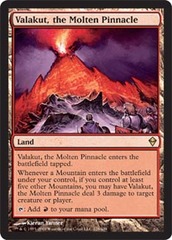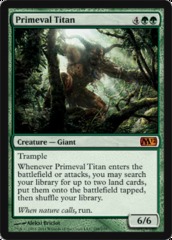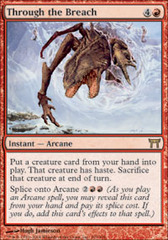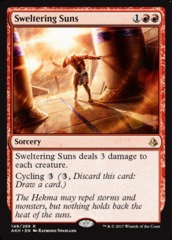Modern Valakut Primer

Modern makes its return to the Pro Tour next year and is the format of choice if you’re looking to qualify: there are still some PPTQs left and anyone who makes it to the RPTQ needs to be confident in their Modern knowledge. At any of those events you can expect Titanshift to be popular: it’s easy to understand and play so it’s a solid choice if you’re new to the format or the game, but it’s also a very powerful deck that has hovered around Modern’s top tier for over a year. Beneath its simplicity there are some important nuances to building and playing the deck that are worth noting no matter which side of the match you’re on.
Background


Valakut offers a unique twist on the classic Ramp archetype that remains a staple of modern Magic as evidenced by the recent success of GW ramp in standard. The fundamental problem with Ramp is the same problem that plagues most combo decks – you need to have specific pieces at certain times, making it easy to punch holes in your draw with interaction and hard to draw action consistently in the late game. A hand with multiple ramp spells but only one payoff card leans heavily on the latter and probably has to find another to beat a decent draw; a hand with lots of payoff cards but only one ramp spell falls apart if that ramp spell can’t do its job or you miss land drops.
Valakut changes all that. Not only does it slot into your lands, giving you extra payoffs without having to sacrifice other spell slots, it turns all of your ramp spells into action when you have enough lands to trigger it. This often lands you in midgame situations where you have to topdeck but you have ten or more outs to win or effectively win on the spot (Scapeshift, Primeval Titan, Summoner’s Pact, as well as Hour of Promise or similar in lists that run them) and another twenty or more cards (Mountains or any land/spell that fetches a Mountain) that can remove a threat and buy you another draw. Having ramp double as action lets you can pack your deck with enough ramp spells to have at least one every game and usually two or more to let you cast Primeval Titan or Scapeshift on Turn 4. Because these rewards come from your lands, a card type that’s hard to interact with in modern/Modern Magic (and for good reason!), you have added protection from the popular interaction in the format. Modern features Thoughtseize, Duress, and Inquisition as Vintage-quality discard spells and Path to Exile, Fatal Push, and Lightning Bolt as hyper-efficient removal (the less said about countermagic, the better…). Outside of Ghost Quarter, which puts them down a card, or Tectonic Edge, which barely sees play, you have to jump through hoops and pay a lot of mana to remove a land; people who write fanfiction about Wasteland being legal in Modern should be careful what they wish for. The main exception to this rule is Blood Moon, which faces stiff competition as the most egregious design mistake to backdoor its way into Modern via 8th/9th Edition. Unsurprisingly, good Blood Moon decks are some of Titanshift’s worst matchups.
This homogeneity comes at a cost: by making your cards do roughly the same thing you care less about card quality, but you still care about card quantity. Scapeshift is described as a ‘one-card combo’ like Tooth and Nail or Gifts Ungiven, but more accurately it’s one specific card plus at least seven lands; it doesn’t care how you get there, but you do need to get there. When Valakut is online it takes over the board but that condition is hard to meet for a reason. Mulligans with Titanshift are still awkward, just not for the same reasons as other decks; having one fewer card matters a lot. Liliana of the Veil is scarier in many games than targeted discard like Thoughtseize as the payoff cards they might want to Thoughtseize are non-functional without the resources to support them. For this reason you have to be wary of playing too many cards that don’t contribute to this plan or replace themselves; those maindeck Lightning Bolts or Anger of the Gods are great in some scenarios and the worst draw in your deck in others. This is also part of the appeal of Through the Breach, which otherwise doesn’t mesh well with the deck – needing just 5 lands and a Titan lets you win from a much lower base.

Matchups
This extra redundancy lets Titanshift boast a great matchup against traditional grindy decks like Jund and Abzan and still a solid matchup against Death’s Shadow, the scourge of fragile combo in Modern. Relic of Progenitus, Chameleon Colossus as a Summoner’s Pact target, other grindy threats such as Tireless Tracker or Thragtusk, and removal like Roast or Dismember for early Death’s Shadows or delve creatures (which the Shadow deck needs to apply enough pressure before you reach Titan/Scapeshift territory), help you to keep the advantage post-board. Grixis Shadow players have adapted with SB hard counters like Flashfreeze or Deprive but the matchup remains positive and a reason to play the deck.
The rise of Eldrazi Tron was a key reason for Titanshift’s recent success; the matchup is comically lopsided. Even their best draws struggle to race yours and your best draws beat theirs. Thanks to the restrictions of Eldrazi Tron’s all-colourless manabase, there are few tools available to improve the matchup. Watch out for Warping Wail!
The matchups against linear deck like Robots or Burn tend to be slightly unfavourable and heavily dependent on the die roll. The hate cards in Modern are strong enough that you can slant these matchups in your favour if you want but your sideboard slots are already tightly squeezed (remember this later!).
Decks that rely heavily on creatures without a fast goldfish – Elves, Company decks – struggle against Titanshift especially if your flex slots are used on Lightning Bolt, Sweltering Suns/Anger of the Gods, and so on. Other combo decks – notably Storm and Ad Nauseam – tend to be very weak matchups as you have no real interaction and a slower goldfish (and few appealing SB options with no way to dig for them in time).

Card Choices
Between 12+ ramp spells, at least 26 lands, and some mix of Primeval Titan/Summoner’s Pact/Scapeshift and other payoff cards, most of the slots in the deck are spoken for. However, the exact distribution of these determines how consistent your deck will be over the course of a tournament and Titanshift pilots still disagree over what the right mix is. You also have some flex slots that give you access to interaction or useful tools pre-board; making the right choices here and drawing those cards at the right time can make or break your tournament.
Sakura-Tribe Elder: The best ramp spell as blocking their biggest attacker while ramping often shifts the race in your favour. Pact for Elder can also give you the final land for Scapeshift or finish a chain of ramp spells to turn on a Valakut. It can also attack for a few points to get your opponent at 18 or below for Scapeshift or at a multiple of 3 for raw Valakut triggers
Farseek: Better than Rampant Growth et al. as being able to fetch a green source that’s also a Mountain is generally more important than access to basic Forest (though watch your sequencing vs Blood Moon or Spreading Seas!)
Explore: The most high-variance ramp spell in that it doesn’t reliably ramp you on turn 2. However, the disaster scenario for Explore – you keep a two-lander with Explore and don’t hit a third – is more obvious but not necessarily more likely than the failure mode of other ramp spells. Consider a hand of 2 lands, 3 Farseek/STE, 2 Primeval Titan. If you don’t hit your third land drop, you have three mana on turn 3 just like a normal draw from any deck but you’ve spent your whole turn 2 to get there; if you miss a land drop at any point, the first ramp spell is worse than a land. There’s a compelling argument for playing more lands and more Explores as, even if the raw quantity of ramp spells in your deck is lower, the likelihood of getting a turn 4 Titan or whatever may actually be higher. Explore also digs for your interactive cards, which tend to be very important as well as time-sensitive in the matchups where you need them, and only ‘costs’ 1 mana if your extra land is untapped so it’s easier to chain ramp spells together.
Khalni Heart Expedition: Another card with a high ceiling and low floor; any Valakut player can tell you stories of just needing to draw any land or ramp spell and peeling Expedition instead. It’s an odd card in that it fixes the problem of needing multiple ramp spells to reach critical mass but you need to draw enough lands and ramp to turn it on in the first place. It’s unclear if it’s better in the interaction-heavy lists, where you have fewer slots for ramp and therefore need individual ramp spells to pull more weight, or in the all-in ramp lists which can trigger it and benefit from it more easily. With both lands entering play at the same time, it’s much easier to trigger Valakut multiple times in the same turn, buying you time for your ‘true’ payoff card. If things go to plan, you can also T2 Expedition, T3 ramp spell, T4 crack Expedition + Scapeshift for lethal; if they don’t, you can mini-Scapeshift for Valakut and some other lands to pile counters on Expedition and set up this double-trigger play.
Prismatic Omen/Hour of Promise: Some Valakut lists would run one or two copies of Prismatic Omen as a cheap payoff card that gets underneath counters and makes your other payoff cards much more powerful – a naked Valakut is much stronger with Omen in play, and Scapeshift goes from usually lethal with 7 lands to definitely lethal with 6. The card received much more attention with Hour of Promise – with Omen in play, Hour for double Valakut gets you four triggers (or six with a Valakut already in play) and you only need one ramp spell to set this up by turn 4. The all-in list below shows off the impressive things Omen can do in this archetype.
Lightning Bolt/Relic of Progenitus/Sweltering Suns: These are just a few of the interactive cards commonly found in the flex slots. Lightning Bolt being bad in the format is awkward for Valakut, not just because it’s a highly efficient and appealing removal spell in a vacuum but because your deck is built around setting up its namesake card to fire a barrage of Bolts! As these effects are so conditional, cards that can replace themselves have a much better case (Sweltering Suns over Anger of the Gods, for example)
Summoner’s Pact: This is viewed as the worst payoff card – a Primeval Titan with added costs – but it’s often one of the best. A small change I’ve liked a lot in Titanshift is playing more copies of Pact over the 4th Titan. One of the easiest ways to lose with Titanshift is to stall on lands with a hand full of Titans and Scapeshifts; Pact gives you something to do there. As mentioned, Pact for Sakura-Tribe Elder or Wood Elves is a useful tactic, but even more important is consistent access to sideboard cards. Obstinate Baloth is found in almost every Valakut sideboard as a great card against Burn and a necessary tool against Liliana; Reclamation Sage is your only real out to Leyline of Sanctity or Blood Moon; Chameleon Colossus is the best card against Grixis Shadow. Having extra virtual copies of these cards makes those matchups much better and, in my view, outweighs the added weakness to disruption and the awkward sequencing that Pact sometimes forces.

Lists
Many different flavours of Valakut have had success; the core of the deck is strong enough that most variations on that shell are competitive. This pair of lists illustrates the distinctions and choices discussed so far:
Simon Nielsen, Top 8 at GP Birmingham:
1 Bloodstained Mire
3 Cinder Glade
3 Explore
3 Farseek
2 Forest
3 Lightning Bolt
6 Mountain
1 Pia and Kiran Nalaar
4 Primeval Titan
1 Prismatic Omen
2 Roast
4 Sakura-Tribe Elder
4 Scapeshift
4 Search for Tomorrow
1 Sheltered Thicket
4 Stomping Ground
2 Summoner’s Pact
1 Sweltering Suns
1 Thragtusk
4 Valakut, the Molten Pinnacle
1 Verdant Catacombs
1 Windswept Heath
4 Wooded Foothills
1 Ancient Grudge
1 Anger of the Gods
1 Beast Within
1 Lightning Bolt
1 Nature’s Claim
3 Obstinate Baloth
1 Reclamation Sage
2 Relic of Progenitus
1 Spitebellows
1 Thragtusk
2 Witchbane Orb
Collins Mullen, T32 at SCG Open Syracuse:
3 Cinder Glade
1 Explore
3 Farseek
2 Forest
4 Hour of Promise
4 Khalni Heart Expedition
1 Misty Rainforest
6 Mountain
4 Primeval Titan
3 Prismatic Omen
4 Sakura-Tribe Elder
4 Scapeshift
4 Search for Tomorrow
4 Stomping Ground
1 Summoner’s Pact
4 Valakut, the Molten Pinnacle
3 Windswept Heath
1 Wood Elves
4 Wooded Foothills
2 Anger of the Gods
1 Chameleon Colossus
1 Crumble to Dust
2 Engineered Explosives
3 Lightning Bolt
2 Obstinate Baloth
1 Reclamation Sage
2 Relic of Progenitus
1 Shatterstorm
Nielsen’s list is one of those decks that is clearly the result of extensive tuning and testing… or thrown together at the last minute. You won’t find a conclusive proof that 1 Pia and Kiran Nalaar, 1 Prismatic Omen, and 1 Sweltering Suns are the best cards for those slots, but each serves a specific and useful purpose. Adding more removal and threats to the maindeck frees up sideboard space to let you double down on the right removal/threat configuration for certain matchups.
Meanwhile, Mullens’ list is intently focused on executing its game plan. The many ramp spells and cards that care about ramp play off each other to open up many promising lines:
T2 Khalni Heart Expedition, T3 Prismatic Omen, T4 crack Expedition + Scapeshift
T2 Expedition, T3 ramp, T4 Hour of Promise for 2 Valakuts + crack Expedition etc.
It would be hard to build a Titanshift list that’s more likely to win on turn 4, and this deck won’t suffer the embarrassment of drawing Pia and Kiran Nalaar against Storm or Lightning Bolt against the mirror. On the other hand, these cards now eat up sideboard slots instead and you have less resistance against opposing nut draws from linear decks (and fewer chances to steal games by drawing the perfect singleton for the matchup). One of Mullens’ more recent lists tries to find a happy medium by playing some MD Bolts while maintaining its focus.
I’d be comfortable sleeving up either list – or some other Titanshift variant – for a competitive Modern tournament. In choosing this deck you accept a certain lack of agency and some frustrating swings but, on a good day, the deck feels unstoppable. In any case, if it’s a smart choice – and it often is – then these are secondary concerns. Hopefully after reading this that choice is a more informed one. As always, if you have any questions or ideas, get in touch!





